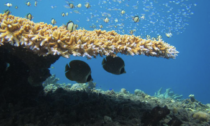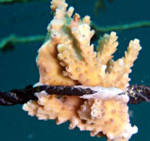
According to a new study, climate change is changing the behaviors of the marine fishes living in coral reefs. This study found that as climate causes bleaching, this affects coral reef butterflyfishes (genus Chaetodon), which eat coral. Hangry butterflyfishes make poorer fight-or-flight decisions that lead to unnecessary fights, so they expend precious limited energy, and this could potentially threaten their very survival due to an increased risk of starvation.
This study was something of an accident. An international team of researchers, led by marine macroecologist Sally Keith, a senior lecturer at Lancaster University, were working on an ongoing study of 38 species of butterflyfishes living on 17 Indo-Pacific reefs off Japan, the Philippines, Indonesia and Christmas Island.
In the midst of this study, disaster struck in 2016 in the form of a global mass coral bleaching event. Acropora corals, the main food source for butterflyfishes, were especially affected. Acropora is a genus of common stony corals comprising table coral, elkhorn coral, and staghorn coral, along with others. These are some of the widespread corals that are major contributors to the immense calcium carbonate substructure that makes up a coral reef.

The 2016 global bleaching event was one of the worst in history. But it did present the researchers the perfect opportunity to study how butterflyfishes’ behaviors were impacted. These reef-dwelling fishes are the first to feel the effects of bleaching because their main food source, coral, diminishes rapidly and almost immediately.
Dr Keith and her collaborators found that coral bleaching forced butterflyfish species to re-focus their diets on consuming what’s still left, which then pushes them into direct competition with other species for the same dwindling food resources and territories.
“Using a mass coral mortality event as a natural experiment and 3,770 field observations of butterflyfish encounters, we test how rapid resource depletion could disrupt recognition processes in butterflyfish,” the authors write.
Wearing snorkels or scuba gear, the team followed 38 free-swimming butterflyfish species, 32 of which were observed in five or more encounters with five or more focal individuals — the criteria for inclusion in the researchers’ statistical analyses — across 3770 encounters.
Dr Keith and her collaborators discovered that the butterflyfishes’ ability to recognize competitor species and respond appropriately was adversely impacted by bleaching.
“By recognizing a competitor, individual fish can make decisions about whether to escalate, or retreat from, a contest — conserving valuable energy and avoiding injuries”, Dr Keith said in a statement. To do this, visual signals act as ‘rules of engagement’ between butterflyfishes of the same and different species.
Basically, when a butterflyfish signals to a competitor that a particular coral patch is theirs, they point their noses down and raise their spiny dorsal fins.
“It’s almost like raising your hackles”, Dr Keith said.
If this visual warning fails to deter a competitor, one fish will chase the other, until one of them gives up.
These chases are exhausting.
“I followed one for about 50 meters (165 feet) once, that was quite tiring, they’re very fast”, Dr Keith explained.
Before the 2016 bleaching event, Dr Keith and her collaborators found that butterflyfishes were able to resolve their disputes by using visual signals around 28% of the time. However, after the bleaching event, interactions became more aggressive: just 10% of disputes were resolved by visual signalling, indicating a large increase in ‘unnecessary attacks’ (Figure 1). Dr Keith and her collaborators also found that signalling between fish of different species became less common after the bleaching event, so encounters escalated to chases in more than 90% of cases – up from 72% before the event.

Dr Keith and her collaborators also found that the distance of these chases increased after coral bleaching, requiring the fish to expend more energy.
These findings are worrying; suggesting that, if mass coral bleaching continues, it’s possible that subsequent behavior changes could have strong negative implications for these species’ very survival.
“Making poor decisions about who to fight, and where to invest their really valuable energy, could be that little bit that tips them over the edge towards actual starvation”, Dr Keith said.
But these interactions are occurring everywhere as climate change worsens, not just amongst coral reef butterflyfishes, so these colorful fishes may provide important clues for what we can expect in the near future as the planet gets ever warmer. Already, we know this climate scenario is rapidly approaching: last year, modelling research indicated that even if the Paris climate goal of just 1.5 degrees Celsius is reached, 99% of the world’s coral reefs will die (ref). If the planet reaches 2 degrees Celsius (which is likely), 100% of the world’s coral reefs and all their citizens will disappear.
Forever.
“By looking at how behaviour responds to real-life changes in the environment, and by seeing that those changes are the same regardless of location, we can start to predict how ecological communities might change into the future”, Dr Keith said. “These relatively small miscalculations in where to best invest energy could ultimately push [species] over the edge.”
At this point, it is not clear whether butterflyfishes can adapt quickly enough to the changes caused by coral reef bleaching. But we do know that these global environmental changes are disrupting millions of years of evolution that allowed such an astounding collection of fish species to coexist in the same habitat. We also know that such changes in the relationships between species within a single community can reverberate up the food web.
“These rules of engagement evolved for a particular playing field, but that field is changing”, Dr Keith pointed out. “Repeated disturbances, such as bleaching events, alter the abundance and identity of corals – the food source of butterflyfish. It’s not yet clear whether these fish have the capacity to update their rule book fast enough to recalibrate their decisions.”

Source:
S. A. Keith, J-P.A. Hobbs, L. Boström-Einarsson, I. R. Hartley and N. J. Sanders (2023). Rapid resource depletion on coral reefs disrupts competitor recognition processes among butterflyfish species, Proceedings of the Royal Society B: Biological Sciences290(1990):20222158 | doi:10.1098/rspb.2022.2158















Social Profiles